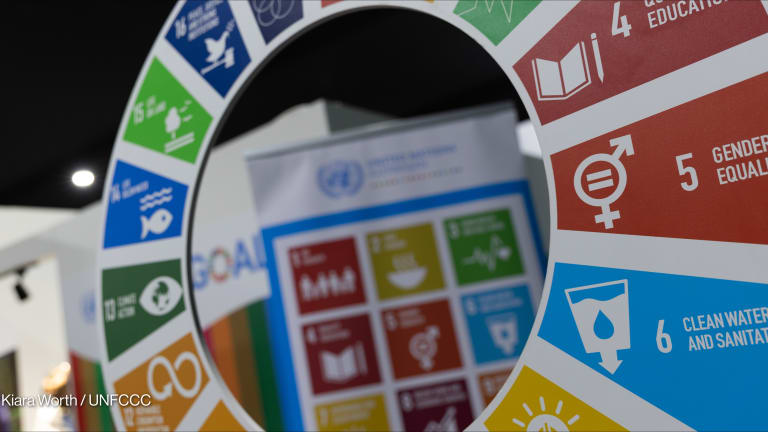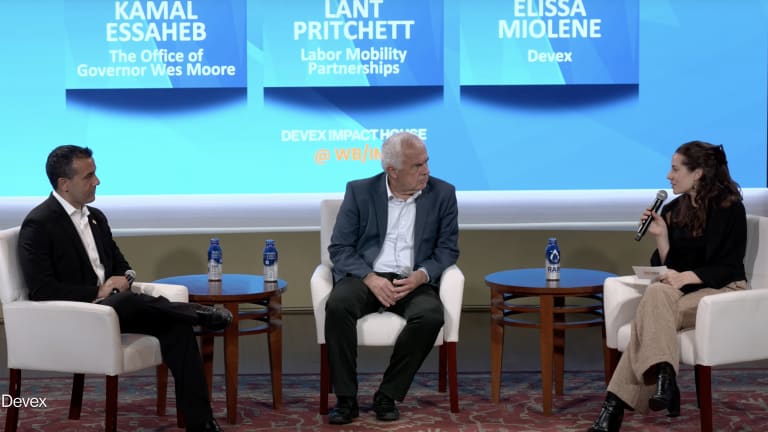
The World Bank Spring Meetings, framed by transformations in development finance, kicked off with a quiet side event detailing how India could virtually eliminate poverty from its shores in one fell economic policy swoop.
The country, which contains roughly one of every three poor people in the world, is exploring the possibility of implementing a universal basic income, which would see Indian states, or the federal government, deliver regular digital payments to Indian citizens.
Some estimates suggest a country-wide universal basic income could reduce India’s absolute poverty rate from 22 percent to less than 1 percent, but plenty of questions remain about the political and logistical hurdles that stand in the way of achieving such a dramatic result — and what some of the other consequences would be of such a major policy shift.
Four blocks from the World Bank’s H Street headquarters in Washington, D.C., the Center for Global Development hosted a conversation between Arvind Subramanian, chief economic adviser to the government of India, and Annie Lowery, contributing editor at The Atlantic.
What has enabled India to consider whether a universal basic income could be an effective lever to address the country’s staggering inequality and persistent extreme poverty is the emergence of a three-part infrastructure that could make the delivery of such payments possible. Mobile phone uptake, financial inclusion, and a massive biometric identification campaign are combining to create a platform by which the government could conceivably reach all of its citizens with digital payments.
But India will have to find an appropriate balance between protecting individual privacy, safeguarding cyber-security, and integrating such a powerful digital platform into its social welfare system, Subramanian said.
He described two distinct conversations taking place about universal basic income and its poverty-fighting potential. One revolves around relatively small direct cash transfer programs, targeting handfuls of villages in sub-Saharan Africa and mostly relates to the effectiveness of donor assistance to developing countries.
The other conversation, more relevant to India’s case, is about macro-level economic interventions that would operate at a much larger scale and with potential society-wide consequences for poverty, economic policy and governance.
In cases like India’s, “the question of whether or not it benefits 100 villages might be moot,” Subramanian said.
India’s exploration of a universal basic income raises macro-level questions that extend beyond this village-by-village impact discussion, Subramanian said. For example, since the payment transfer would likely amount to 4 or 5 percent of India’s GDP, how would the country pay for it? To answer that major question, India’s state and national leaders will have to consider how a universal basic income would interact with — or perhaps replace — existing social welfare programs.
India already provides citizens a number of subsidies, including for fertilizer, gas and kerosene. If the government sought to replace those with a universal basic income payment, it could run into resistance from people unwilling to let go of old entitlements, even when presented with new ones. India’s policymakers will also have to ask themselves whether the advantages of a universal basic income are great enough to justify dismantling aspects of an existing social welfare system many feel has started to work fairly well, Subramanian said.
He added that a universal basic income scheme should not allow the government to abrogate its responsibility to provide basic public services such as health and education, as some critics of UBI have feared it might. So far the relatively small state of Madhya Pradesh is the first to implement a UBI pilot that was set up in a handful of villages.
Devex reporters Michael Igoe and Sophie Edwards will be on the ground at the World Bank Spring meetings April 18-22. Stay tuned to Devex for coverage and follow @Sophie_Ed1984 and @AlterIgoe.








